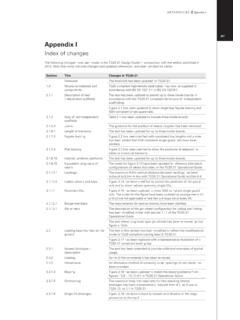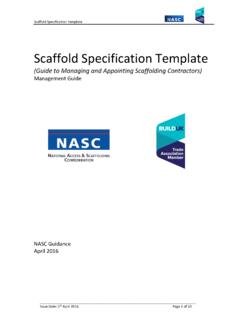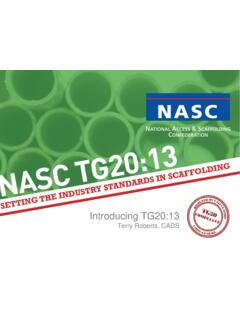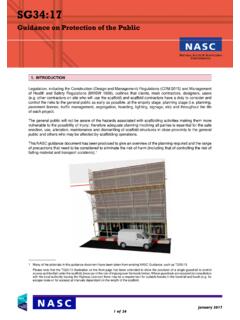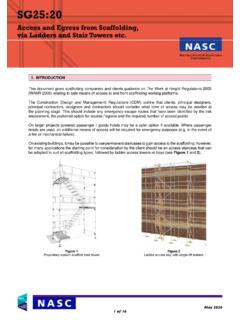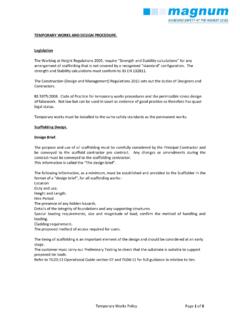Transcription of Changes from TG 20:13 - NASC
1 216 SectionTitleChanges in tg 20 20 compliance sheetsThe layout of the tg 20 :21 compliance sheet has been significantly revised since TG 20:13 . The compliance sheet now spans two pages, with an illustration of the scaffold and the principal compliance criteria on the first page and the detailed compliance criteria, similar to the contents of a TG 20:13 compliance sheet, on the second of tg 20 scaffoldingThe types of tg 20 compliant scaffolding have been extended to include tube and fitting tied independent scaffolding with up to three inside boards, external birdcages, mobile towers and loading bays constructed without beams. tg 20 compliant loading bays with beams have also been modified, replacing the 5 board wide loading bay from TG 20:13 with two variants: a 6 + 2 board wide loading bay and a 3 + 4 + 3 board wide loading 20 compliance sheetsThese sections have been revised to explain the principal features of a tg 20 :21 compliance sheet.
2 The TG 20:13 Operational Guide contained a significant number of compliance sheets that have not been reproduced in tg 20 :21, other than some representative effect of the site locationThe illustration of the tg 20 wind factor bands in Great Britain and Ireland has been retained, but the manual procedure for determining the site wind factor has been omitted from the Operational Guide. The tg 20 :21 wind factor is calculated automatically by the tg 20 :21 eGuide, with a manual procedure provided in the tg 20 :21 Design , 20 eGuideThis section of the guide has been revised to explain the operation of the tg 20 :21 eGuide, which has been updated significantly to display a visualisation of the scaffold. The eGuide has also been extended to include the tg 20 :21 compliant scaffold types and to support the selection of the number of boarded lifts, in comparison with TG 20:13 that conservatively assumed a fully-boarded guidance for cold formed high-tensile steel tubes from TG 20:13 Supplement 1 has been guidance for the maintenance of scaffold boards has been revised in line with TG 6 for supplementary and check couplers has been provided from TG 14:20.
3 Clarification has been added that a wedge coupler may be used as a right-angle beamsAdditional guidance has been provided to assist with the identification of tg 20 compliant aluminium lattice beams. Practical guidance has also been included for the use, transportation and storage of revisions have been made following the introduction of the BS EN 131 Professional ladder class and the withdrawal of BS 1129 and BS foundationsThe guidance for when sole boards should be used in addition to high-visibility plastic plates has been foundation loadsThis section has been simplified to relate the minimum sole board requirements to the maximum leg load reported by the tg 20 compliance sheet, rather than explicitly providing tables of leg usage and load classThis section has been updated to permit up to three inside widthsThis section has been updated to permit up to three inside in standards and ledgersThis guidance has been simplified to recommend sleeve couplers for tg 20 compliant scaffolding and clarify that joint pins are not recommended.
4 Clarification has been added that tube-lock connections may alternatively be guidance for board bearing transoms has been extended to permit three inside boards, with guidance provided for minimising the deflection of the transoms in this case. The requirement for a minimum 25 mm projection of the transom tube has been removed, provided that the tube projects past the coupler. The guidance for structural transoms has been clarified to state that they may be connected to the standards or to the bracingGuidance has been provided to ledger brace below the first lift in the direction diagonally away from the fa ade, for stability when the scaffold is one lift tall. The ledger bracing may be in either direction for a tied from TG 12 has been added for securing boards with small diameter boards and bracketsThis section has been amended to permit up to three inside boards and to reference section for the guidance for minimising the transom deflection with three inside cantilevered platformsThe guidance for tying the lift supporting the cantilevered platform has been from TG 20:13 The principal differences between the TG 20:13 and tg 20 :21 Operational Guides are summarised by the following table.
5 Note that minor editorial Changes and Changes to illustrations that do not have a material impact on the guidance have been omitted for 19 | AppendixNATIONAL ACCESS AND SCAFFOLDING CONFEDERATION217 SectionTitleChanges in tg 20 edge protectionThe definition of the maximum service gap dimension has been clarified to note that it is measured from the inner face of the standards where an inner platform is not alternative layout of rakers has been provided that does not require ground anchors. The external raker configuration has been modified to no longer require plan or fa ade new requirement has been specified that structural transoms should be connected to each pair of standards if an untied single-lift scaffold is not supported by 20 tie complianceThis section has been revised to reference the contents of the tg 20 :21 compliance 20 tie patternsThe guidance for laying out ties is unchanged, but has been rephrased now that a tg 20 tie pattern is shown on the illustration on the first page of a tg 20 :21 compliance sheet.
6 For spacing tiesThis guidance is unchanged, but has been rephrased to state that it is used where the idealised tie pattern from a compliance sheet cannot be followed due to site returnsThe qualifying criteria for adjacent returns have been revised to clarify that the adjacent elevation must be assembliesGuidance has been provided for the use of K-bracing where a tie tube is more than 300 mm from a principlesTable (guidance for additional sway resistance) has been updated for three inside couplersAn illustration has been provided of a typical tie assembly to steelwork with girder towersThe guidance for the use of compliance sheets with proprietary staircase towers has been clarified with additional details of the information required from the manufacturer or supplier. The guidance for erecting tube and fitting stairs without a design has been towersThe maximum recommended vertical distance between landings has been reduced from m to m in line with SG 25:20.
7 The edge protection guidance has been updated to state that additional guard rails may be provided to maintain a maximum 470 mm vertical gap if deemed methods of ladder accessGuard rails have been shown around the external ladder in figure platformsThe maximum recommended vertical distance between landings has been reduced to m for internal ladders and m (two lifts) in line with SG 25 of laddersThe safety guidance has been updated in line with SG 25 specificationExamples of typical tg 20 compliant aluminium beams have been the beamsA clarification has been added that beams should not be connected at the horn ends . It has also been clarified that the bearer transoms act as lacing tubes and supplementary and bracing the beamsIt is now recommended that section bracing is always provided, including the case where steel ladder beams are the beam systemTable (the number of beam systems required) has been updated for three inside of the publicThe cover image has been updated to show a single guard rail to prevent the risk of tripping over the traffic barrier.
8 All illustrations have been updated to show representative safety coverings over the couplers, whereas TG 20:13 provided a note to this liftsA note has been provided that suitable breaks in the handrail and baulk may be required to provide an access or escape route. The requirement for the client to provide lighting has been qualified to be where deemed necessary in line with SG 34 a pavement liftFigures have been corrected to remove the ties from the rightmost wheelsThe guidance for the safe use, inspection and handover of gin wheels has been revised in accordance with SG 9:21. The examples of maximum loads that can be lifted have been increased while remaining within the 50 kg lifting methodsThe maximum permitted weight for a hand line has been increased from 20 kg to 28 kg, in line with SG 9:21, to permit a 21 tube to be chutesA maximum vertical height of 10 m is recommended in accordance with TG 3 baysThis chapter has been rewritten to provide guidance for tg 20 :21 compliant loading bays, which may be 6 + 2 or 3 + 4 + 3 boards wide, constructed with or without has been provided for external birdcages, in addition to the internal birdcage definition from TG 20:13 .
9 tg 20 :21 compliant birdcages may be fully boarded at multiple lifts if required. The maximum height-to-base ratio for free-standing internal birdcages has been conservatively reduced from 4 : 1 to 3 : or mobile towersGuidance has been provided for tg 20 :21 compliant mobile shaft towersThe guidance has been updated to permit a second lift to be very lightly client briefAdditional criteria for consideration in the client brief have been included from TG 21 , assessments. Method statementsThese sections have been updated in line with SG 7 section has been updated to reference CPD (Continuing Professional Development) and the CISRS card certificatesThe sample handover certificate has been updated to match SG 35
